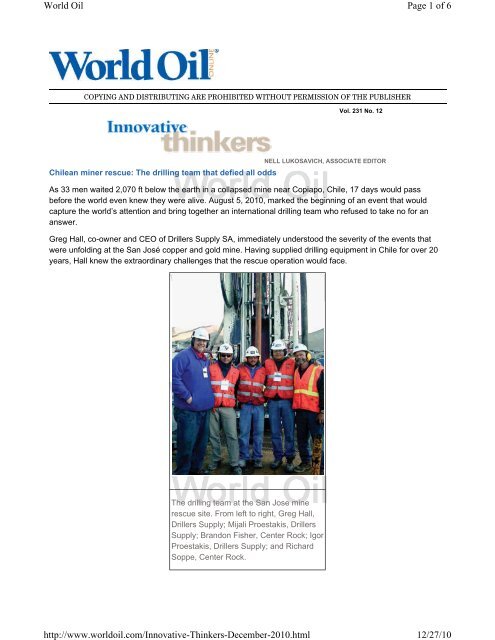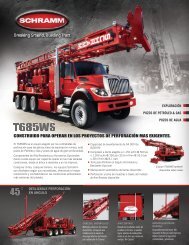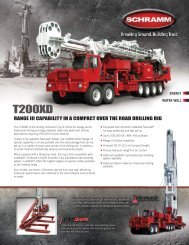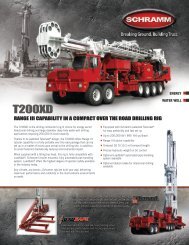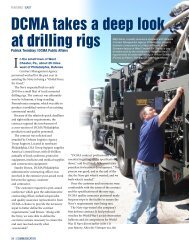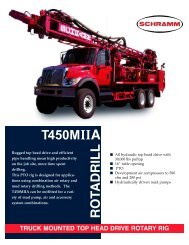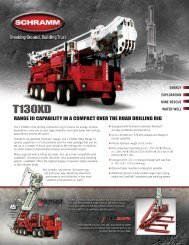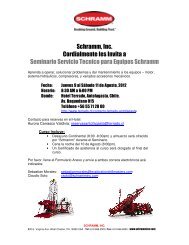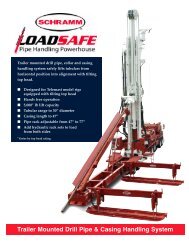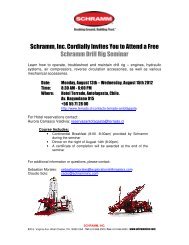Chilean Miner Rescue: The Drilling Team That ... - Schramm Inc.
Chilean Miner Rescue: The Drilling Team That ... - Schramm Inc.
Chilean Miner Rescue: The Drilling Team That ... - Schramm Inc.
You also want an ePaper? Increase the reach of your titles
YUMPU automatically turns print PDFs into web optimized ePapers that Google loves.
World Oil<br />
http://www.worldoil.com/Innovative-Thinkers-December-2010.html<br />
Page 1 of 6<br />
12/27/10<br />
COPYING AND DISTRIBUTING ARE PROHIBITED WITHOUT PERMISSION OF THE PUBLISHER<br />
Vol. 231 No. 12<br />
<strong>Chilean</strong> miner rescue: <strong>The</strong> drilling team that defied all odds<br />
NELL LUKOSAVICH, ASSOCIATE EDITOR<br />
As 33 men waited 2,070 ft below the earth in a collapsed mine near Copiapo, Chile, 17 days would pass<br />
before the world even knew they were alive. August 5, 2010, marked the beginning of an event that would<br />
capture the world’s attention and bring together an international drilling team who refused to take no for an<br />
answer.<br />
Greg Hall, co-owner and CEO of Drillers Supply SA, immediately understood the severity of the events that<br />
were unfolding at the San José copper and gold mine. Having supplied drilling equipment in Chile for over 20<br />
years, Hall knew the extraordinary challenges that the rescue operation would face.<br />
<strong>The</strong> drilling team at the San Jose mine<br />
rescue site. From left to right, Greg Hall,<br />
Drillers Supply; Mijali Proestakis, Drillers<br />
Supply; Brandon Fisher, Center Rock; Igor<br />
Proestakis, Drillers Supply; and Richard<br />
Soppe, Center Rock.
World Oil<br />
http://www.worldoil.com/Innovative-Thinkers-December-2010.html<br />
Page 2 of 6<br />
12/27/10<br />
As local companies began to mobilize their rigs, which were capable of drilling to about 1,400 ft, geologists<br />
began to suspect that the miners were trapped much farther down. In the days following the cave-in, Drillers<br />
Supply teamed up with local officials and drilling contractors to employ nine rigs, including four <strong>Schramm</strong><br />
T685WS reverse-circulation exploration rigs, to drill a series of pilot holes to search for the miners.<br />
“By day seven or eight, we thought we were drilling a recovery operation. We were looking for bodies,” said<br />
Hall. <strong>The</strong>n, on Aug. 22, the team got some very unexpected news. “We heard banging on the drill pipe and<br />
realized that someone was alive down there,” said Hall.<br />
One of the <strong>Schramm</strong> rigs had successfully reached the trapped miners with a 5½-in. borehole. “<strong>The</strong> miners<br />
saw [the drill pipe] and, with red paint, they wrote a message on the end of the [drillstring],” said Jeff Roten,<br />
<strong>Schramm</strong>’s service technician who stayed onsite throughout the entire operation. <strong>The</strong> message stated, simply:<br />
“All 33 of us are well inside the shelter.” Miraculously, the miners had survived 17 days with minimal supplies.<br />
In just two more days, they would have run out of food.<br />
Jeff Hart, of Layne Christensen, one of the operators of the<br />
<strong>Schramm</strong> T130XD. Photo courtesy of <strong>Schramm</strong> <strong>Inc</strong>.<br />
<strong>The</strong> news personally touched Brandon Fisher, CEO of Center Rock drilling company. Fisher, who grew up in<br />
the mining communities of southwestern Pennsylvania, initially founded Center Rock in 1998. He grew the<br />
company into a drilling product manufacturer and, in 2002, he developed a low-profile (LP) drilling series using<br />
the large-diameter drills—up to 10 ft—initially developed for bridge construction. <strong>The</strong> drills’ percussion<br />
technology proved to be especially effective in drilling through extremely hard material, such as volcanic rock<br />
infused with hard minerals.<br />
Upon hearing that the <strong>Chilean</strong> miners may not be reached until Christmas—five months after the initial mine<br />
collapse—Fisher knew he had to get involved. “It was very close to our hearts,” he said. Fisher was no<br />
stranger to mine rescue operations. In 2002, he had helped save nine miners who were trapped 270 ft<br />
underground after the Quecreek mine in southwestern Pennsylvania collapsed. As water filled the mine shaft,<br />
the rescuers drilled a ventilation hole and a second escape hole, freeing the nine miners after 72 hours.<br />
Before the San José mine collapse, there had never been a successful rescue operation at depths of 2,000 ft.<br />
<strong>The</strong> andesite rock under which the miners were trapped was highly abrasive, with a tensile strength of about<br />
39,000 psi. <strong>The</strong> team also had incomplete mine maps and knew that there were dozens of dangerous mine<br />
passages that, if affected by the vibration from the drill, could cause the mine to further cave in.
World Oil<br />
http://www.worldoil.com/Innovative-Thinkers-December-2010.html<br />
Page 3 of 6<br />
12/27/10<br />
Workers of the T130XD celebrating after completing the<br />
escape hole to free the 33 miners. Photo courtesy of<br />
<strong>Schramm</strong> <strong>Inc</strong>.<br />
Based on the pilot holes initially drilled, <strong>Chilean</strong> officials sought three projects teams, dubbed Plans A, B and<br />
C. Igor Proestakis, sales manager for Drillers Supply in Chile, presented the team’s proposal to the<br />
government committee. “When we told them we could finish in six weeks, about 80% of the committee laughed<br />
at us,” Hall said. “Nobody thought Plan B had a chance, as it was just so different.”<br />
<strong>The</strong> government approved the proposal for Plan B, and on Sept. 4, Fisher, along with several colleagues, met<br />
up with the Drillers Supply team waiting onsite. <strong>Drilling</strong> operations began the next day with <strong>Schramm</strong>’s T130XD<br />
rig, operated by <strong>Chilean</strong> exploration company Geotec Boyles Bros., and Center Rock’s LP drill to ream out the<br />
existing 5½-in. pilot hole to 12 in.<br />
To assist with the drilling operation, Geotec contracted several drilling engineers, including Jeff Hart and Matt<br />
Staffel of Kansas City-based Layne Christensen. <strong>The</strong> two arrived at the mine site from Afghanistan, where<br />
they had been drilling water wells to help US military forces. Hart became the drilling chief of the operation.
World Oil<br />
http://www.worldoil.com/Innovative-Thinkers-December-2010.html<br />
Page 4 of 6<br />
12/27/10<br />
<strong>The</strong> <strong>Schramm</strong> T130XD rig arriving to the San Jose mine<br />
site. Photo courtesy of <strong>Schramm</strong> <strong>Inc</strong>.<br />
While the initial phase of the drilling operation focused on expanding the wellbore to 12 in., the team laid out<br />
plans to continue to expand the hole out to 18 in., then 26 in. to accommodate the rescue capsule system that<br />
would bring the miners to the surface. “We were confident that the T130XD was the right rig for the job. <strong>The</strong><br />
right people and tooling were in place, and we were certain the drilling would be completed well ahead of the<br />
original estimates,” said Greg Hillier, product manager for <strong>Schramm</strong>.<br />
<strong>The</strong> initial pilot hole, drilled at an 80° angle with a series of sharp turns (up to 4° per 10 m), could not<br />
accommodate the percussion hammers that Fisher typically used to drill his large-bore vertical wells. <strong>The</strong> team<br />
re-designed the chuck-bearing system, and within two days of sending the construction plans to the US, the<br />
equipment was headed down to Chile. Through its humanitarian supply chain organization, delivery service<br />
UPS shipped the first equipment from the US to Chile at no charge, and <strong>Chilean</strong> military officials delivered the<br />
materials personally to the site. A majority of the shipments were moved in under 48 hours.<br />
With each day came a new challenge. When the drill bit reached 880 ft, within feet of an existing mine opening,<br />
the pilot hole bit broke off, launching a four-day fishing job. Proestakis, who had been onsite since the pilot<br />
holes were drilled, designed the fishing tool, which included a mounted camera that helped the team search for<br />
the bit. “Every 400 ft or so, only four of the five hammer faces would be touching the rock and they would break<br />
off,” said Hall. “<strong>The</strong> miners would call up to ask why we had dropped a hammer down the hole.”
World Oil<br />
http://www.worldoil.com/Innovative-Thinkers-December-2010.html<br />
Page 5 of 6<br />
12/27/10<br />
Center Rock’s 26-in. LP drill Tool rigging up to go back in<br />
the hole. Photo courtesy of Center Rock.<br />
Supplies were sent to the miners via three pilot hole shafts. One shaft supplied air and water, one supplied<br />
food, and the third was used to supply general materials, including medical supplies. Officials at the US<br />
National Aeronautics and Space Administration worked with nutritional experts to provide specialized foods<br />
and liquids to the miners, as well as clothing that could regulate their blood pressure as they ascended to the<br />
surface.<br />
<strong>The</strong> miners, who exchanged communications with the drillers via a capsule sent through the third pilot hole,<br />
also aided in the drilling operation. “[We] would stop drilling at times to let the miners haul away the cuttings,”<br />
said Dick <strong>Schramm</strong>, chairman of <strong>Schramm</strong>.<br />
Complications with the neck of the drills and the unknown maze of production tunnels that crisscrossed the<br />
shelter caused further delays. “It was one of the most stressful situations you can be in,” Fisher said. “Every<br />
drilling setback was affecting human life. It [upped] the level of urgency and the pressure to get to the bottom<br />
of the hole.”<br />
After a 33-day drilling operation, the team feathered the roof holes and broke through to the miners. On Oct.<br />
12, more than one billion people watched as the first miner, Florencio Ávalos, emerged from the rescue<br />
capsule after being trapped for 69 days. <strong>Chilean</strong> President Sebastián Piñera greeted him with the words:<br />
“Welcome to life.” Within 24 hours, all 33 men were reunited with their loved ones and hundreds of supporters<br />
who gathered to welcome the miners at the rescue site, named Campamento Esperanza, or Camp Hope. “It<br />
was a very emotional moment,” Fisher said.<br />
Since the historic rescue in Chile, Fisher and Hall have launched efforts with US state and federal agencies to<br />
reinstate the country’s rapid-response drilling program, which was disbanded in 1975. Fisher is also working<br />
with officials abroad to develop emergency response drilling procedures.<br />
“We had the best people, the best equipment. We were determined not to fail,” Hall said. “<strong>The</strong> miners had faith<br />
and never gave up hope. <strong>That</strong> gave us the impetus to go one more night without sleep … It’s a crucial<br />
difference when you’re drilling for people, not for profit.”
World Oil<br />
http://www.worldoil.com/Innovative-Thinkers-December-2010.html<br />
Page 6 of 6<br />
12/27/10


